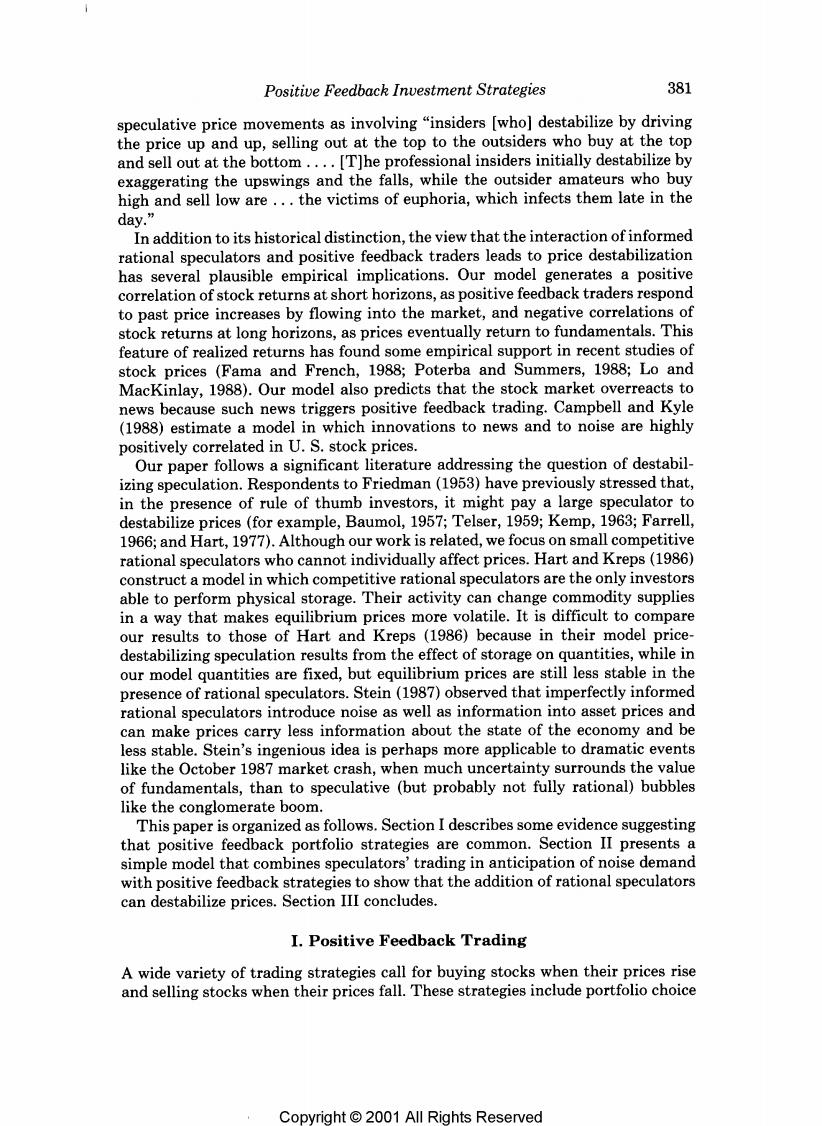正在加载图片...

Positive Feedback Investment Strategies 381 speculative price movements as involving "insiders [who]destabilize by driving the price up and up,selling out at the top to the outsiders who buy at the top and sell out at the bottom....[T]he professional insiders initially destabilize by exaggerating the upswings and the falls,while the outsider amateurs who buy high and sell low are...the victims of euphoria,which infects them late in the day.” In addition to its historical distinction,the view that the interaction of informed rational speculators and positive feedback traders leads to price destabilization has several plausible empirical implications.Our model generates a positive correlation of stock returns at short horizons,as positive feedback traders respond to past price increases by flowing into the market,and negative correlations of stock returns at long horizons,as prices eventually return to fundamentals.This feature of realized returns has found some empirical support in recent studies of stock prices (Fama and French,1988;Poterba and Summers,1988;Lo and MacKinlay,1988).Our model also predicts that the stock market overreacts to news because such news triggers positive feedback trading.Campbell and Kyle (1988)estimate a model in which innovations to news and to noise are highly positively correlated in U.S.stock prices. Our paper follows a significant literature addressing the question of destabil- izing speculation.Respondents to Friedman(1953)have previously stressed that, in the presence of rule of thumb investors,it might pay a large speculator to destabilize prices (for example,Baumol,1957;Telser,1959;Kemp,1963;Farrell, 1966;and Hart,1977).Although our work is related,we focus on small competitive rational speculators who cannot individually affect prices.Hart and Kreps(1986) construct a model in which competitive rational speculators are the only investors able to perform physical storage.Their activity can change commodity supplies in a way that makes equilibrium prices more volatile.It is difficult to compare our results to those of Hart and Kreps (1986)because in their model price- destabilizing speculation results from the effect of storage on quantities,while in our model quantities are fixed,but equilibrium prices are still less stable in the presence of rational speculators.Stein(1987)observed that imperfectly informed rational speculators introduce noise as well as information into asset prices and can make prices carry less information about the state of the economy and be less stable.Stein's ingenious idea is perhaps more applicable to dramatic events like the October 1987 market crash,when much uncertainty surrounds the value of fundamentals,than to speculative (but probably not fully rational)bubbles like the conglomerate boom. This paper is organized as follows.Section I describes some evidence suggesting that positive feedback portfolio strategies are common.Section II presents a simple model that combines speculators'trading in anticipation of noise demand with positive feedback strategies to show that the addition of rational speculators can destabilize prices.Section III concludes. I.Positive Feedback Trading A wide variety of trading strategies call for buying stocks when their prices rise and selling stocks when their prices fall.These strategies include portfolio choice Copyright O 2001 All Rights Reserved